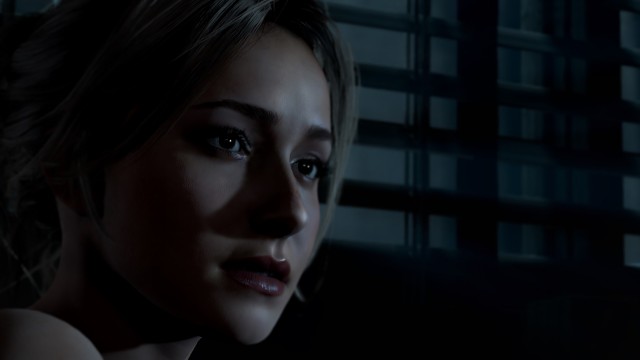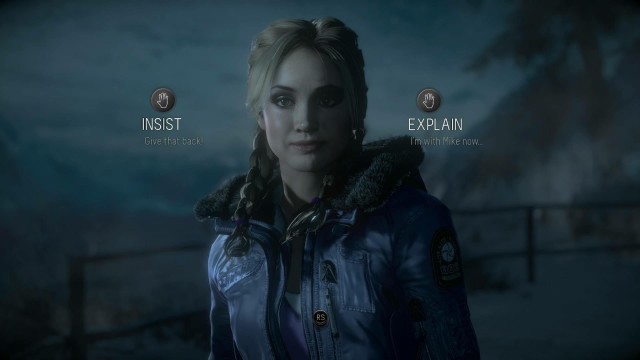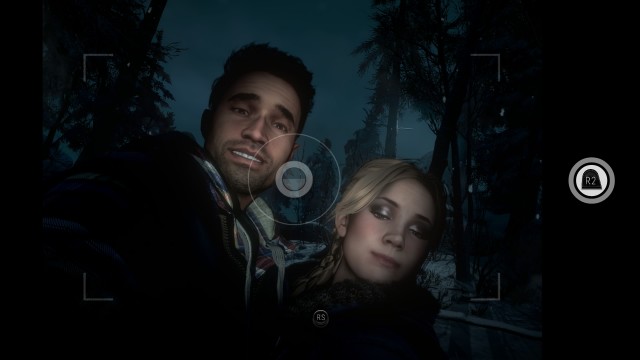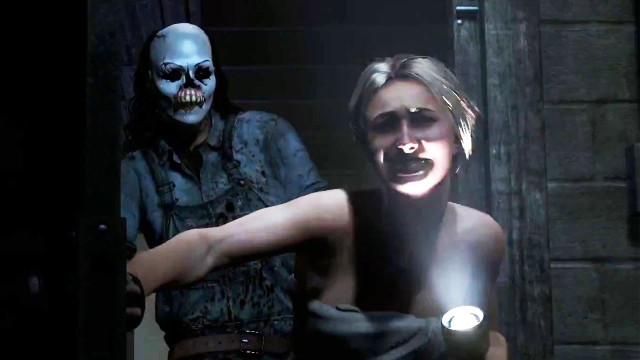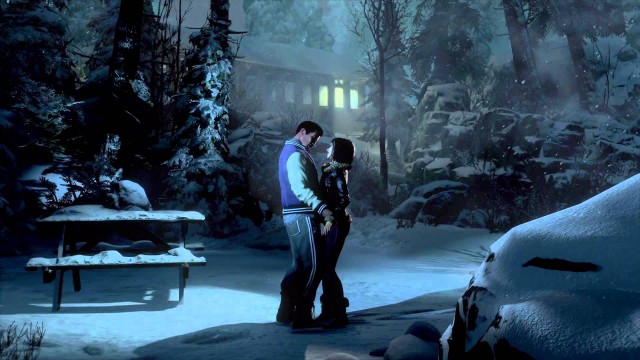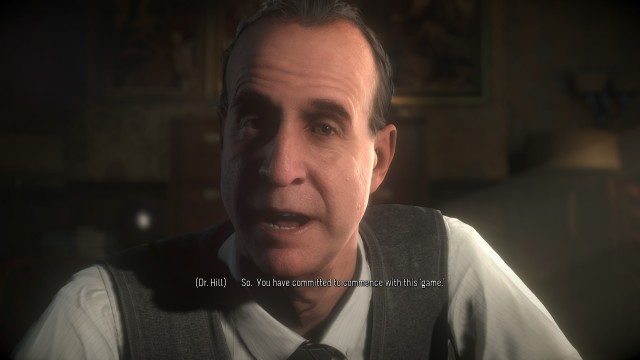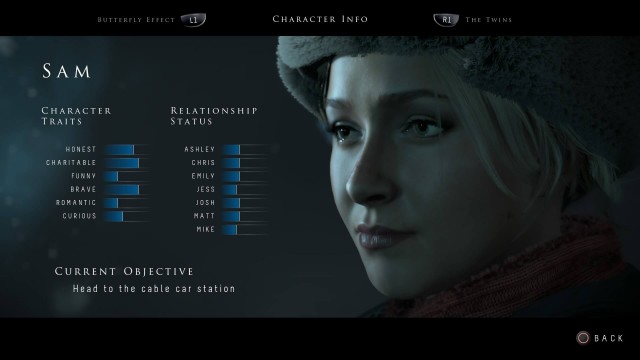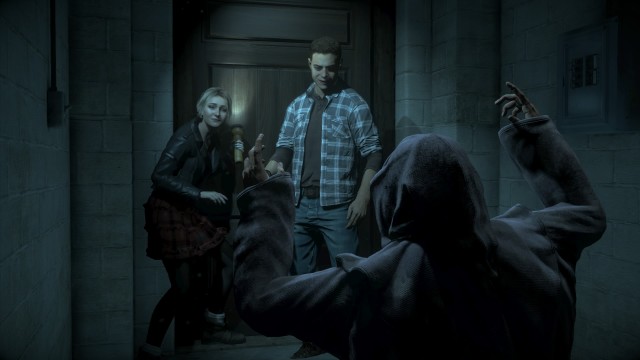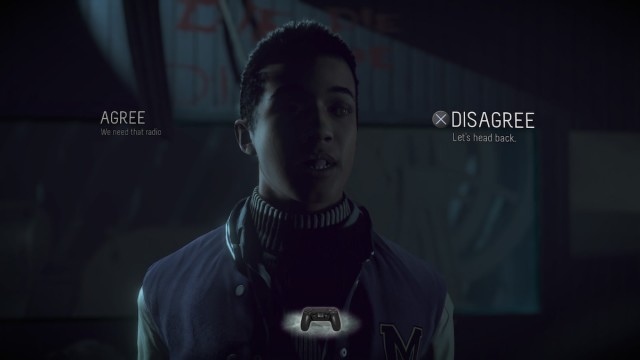When eight friends go to a remote Winter getaway at a secluded lodge on a snowy mountain, their decisions will decide who lives and who dies, when they become stalked by a horror greater than any of them could have imagined.
At first glance, Until Dawn sounds like a cheesy slasher movie, the kind that have been pumped out in droves for decades, ever since movies like Friday the 13th and The Texas Chainsaw Massacre brought them to prominence. What makes Until Dawn distinct however is that it’s not a movie at all, but a PS4-exclusive video game, one that places you in control of the fates of eight young college students, who may indeed live or die, depending on the choices you make.
This idea of interactive, narrative-driven adventure gaming has been touched upon several times by the likes of Quantic Dream and Telltale Games most notably, and yet, Until Dawn feels a cut above those offerings when it comes to its ambitious choice-driven gameplay. The idea of trimming the fat and getting right to the slasher setup, where characters must try to survive a single night of being hunted by certain death, is an inspired one, especially since the focused, modest length of the game allows the so-called ‘Butterfly Effect’ to make even minimal, seemingly benign choices shape the story in some pretty detailed, shocking ways.
Needless to say, Until Dawn is a must-play for horror fans that own a PS4. Even those who simply appreciate great, flexible storytelling will have quite a lot of fun with it, due to its rewarding replayability, amazing production values, and genuinely terrifying presentation. Everything iconic and entertaining about the horror genre is incorporated in some way in Until Dawn. If you never had an appreciation for the horror genre before, Until Dawn might very well change your mind about it.
Until Dawn utilizes state-of-the-art motion-capture performances to bring a cast of recognizable actors into a video game setting like never before. The visuals are pretty outstanding as well, leveraging the enormous processing and rendering power of the PS4, at native 1080p resolution, to produce a mostly unprecedented interactive horror movie-style presentation. Everything about the character models, animation and environmental effects feels eerily real, and effortlessly brings you into the creepy, unpredictable atmosphere of Until Dawn with aplomb!
The highly recognizable faces of Hayden Panettiere, Peter Stormare and others come at a cost though. Despite the sheer, highly impressive beauty of Until Dawn, the ambitious visuals do semi-frequently tax the PS4 hardware, resulting in noticeable framerate drops, even when the game runs at a capped 30fps. Some cutscenes stutter and slow down as a result, and there are a handful of instances where the game seems to interrupt your movement for a second, due to loading hiccups. That’s before a handful of surreal-looking faces in a few scenes as well, with Peter Stormare sometimes looking particularly odd and leathery, while some of the facial expressions from the main protagonists occasionally look unintentionally creepy and alien as well. Fortunately though, this doesn’t happen often enough to feel all that intrusive.
Besides, it’s difficult to dwell on a few motion-capture quibbles when you really allow the engrossing atmosphere of Until Dawn to wash over you. The game’s commitment to realizing the immersive terror of a horror movie is highly commendable, and almost always successful, sucking players in right from the get-go. The game sometimes runs the gamut of cliched horror movie settings, beginning with the ever-recognizable remote cabin in the snow-covered woods, within a mountain that happens to feature inevitable horror locales like abandoned mines and equally abandoned insane asylums, but it all works to create a game that clearly has an intimate love and knowledge of the horror genre. The excellent lighting and shading makes every setting feel all the more harrowing as well, with visible dust particles, realistically disturbed dirt and snow, and credible wood-chipping and flame-burning all contributing to creating a series of environments that feel alive and immersive.
Immersion is key too, because it means that players will easily take to the whole idea of a game so aggressively driven by choice. When their choices are reflected in environments that may hold or fall apart, character models that may end up more bloodied and bruised from certain actions, and other such visual factors that feel as realistically reactive as the story is, it helps to make players truly feel like they are part of the experience, and that their choices matter as far more than a few lines of changed dialogue.
Not to be outdone by the incredibly immersive and well-realized visuals, Until Dawn’s audio is also realized in outstanding fashion. The original score by Jason Graves, one of the most frequent horror-themed composers in gaming, between his work on EA’s Dead Space games, 2013’s Tomb Raider reboot, and Sony’s very own The Order: 1886 from this year, is sterling horror material, subtly keeping tension high whenever it’s not simply letting ambiance do the talking. The crowning composition of the great soundtrack also comes by way of its vocalized single, “O Death”, composed by Graves, and sung by Amy Van Roekel, a revamped version of the old folk song of the same name, which beautifully complements the game’s campy, but brutal horror stylings.
The sound effects are also often outstanding, with the sound mixing being pitch-perfect, and nicely feeling credible and grounded as players realistically navigate environments, while also knowing when to play up the sharpness to emphasize creaks, groans and shrieks. There are quite a few good jump scares in Until Dawn, which are pulled off beautifully with nicely sharp chords and audio mixing, even if some of them are simple cat scares that are meant to build up atmosphere as the young protagonists goof off and prank each other, oblivious to the true horror that is about to come after them. Those that are annoyed by jump scares may find that Until Dawn leans on them a bit too much during certain sections of gameplay, but it’s understandable that the game is proud of them, since it’s quite good at scaring even hardened horror enthusiasts, especially when the overabundance of jump scares never comes at the expense of many other varieties of effective scares throughout the story.
In fact, the game is so proud of its jump scares, that those who own a PlayStation Camera will be in for an especially hair-raising surprise! During certain jump scare moments, if you have a PlayStation Camera plugged in, it will record your reactions to the jump scare without your knowledge, and then play it back for you when you pull up your video captures from the game menu. It’s goofy and superfluous, but if you’re playing with another person beside you especially, it can be pretty good for some laughs.
As you can expect, the voice acting is also sublime in Until Dawn, making great use of several recognizable faces, from Heroes’ Hayden Panettiere, to Mr. Robot’s Rami Malek, to Agents of S.H.I.E.L.D.’s Brett Dalton, to Superstore’s Nichole Bloom, to Peter Stormare, who has too many awesome roles to count, though you’d recall him most recently from Arrow. The voice acting is some of the best in any video game to date, and perfectly captures the conviction and occasional silliness of camp horror, furthering the feeling that you’re legitimately playing an interactive horror movie. There are a handful of recycled voice clips that the game tries to sneak in here and there, but this is pretty rare, especially when the script does such a great job of being varied and faithful to the adolescent nastiness of so many horror stories of this ilk.
As arresting a visual experience as Until Dawn is, it’s perhaps an even better audio experience. Everything has been finely crafted to emulate the audio stylings of a potent, terrifying and yet vaguely self-indulgent horror flick, creating an experience that feels faithful to both the best and the silliest of 80’s and 90’s horror movies in particular, yet also works sublimely as a video game audio suite on its own merits, packing in scads of engrossing tension and frights.
If you’ve played PlayStation-exclusive titles like Heavy Rain or Beyond: Two Souls, or even multiplatform Telltale projects like The Walking Dead, you should feel right at home with Until Dawn, which proceeds in a similar fashion. As with the Quantic Dream games in particular, players take control of several protagonists, cycling between them over the course of the ten-episode story, and seeing how decisions both big and small will change the outcome for all of the protagonists.
Of course, the big challenge in Until Dawn isn’t in any kind of direct gameplay obstacle. Much of the game unfolds with simple quick-time events and choice prompts, outside of more large-scale adventure-style exploration sections that necessitate some clever thinking and observation to proceed. More than any kind of real obstacle, Until Dawn instead challenges players to forge their own story. Sure, Quantic Dream has done this with Heavy Rain in particular, another game with an ensemble of leads that may live or die, depending on the player’s choices, but Until Dawn takes things a step further than Heavy Rain. This time, it’s entirely possible to save everyone, though it’s also possible to end the story with no survivors. It’s not quite a feeling of no two playthroughs feeling alike, as the basic outline of events is much the same for surviving characters in most cases, but it’s pretty damn close.
Originally, Until Dawn was planned for the PS3, and was meant to be a game designed around PlayStation Move as well. Much of that original design has been thrown out and drastically re-tooled for a successful realization of the project on PS4 though, and the PlayStation Move feature has been dumped in the final PS4 build, with the game now exclusively being playable with the standard Dual Shock 4 controller. That said however, you can still elect to play Until Dawn with motion controls, thanks to the Dual Shock 4’s built-in gyroscopic sensors.
If you prefer, you can make use of traditional controls that solely rely on moving the analog sticks in place of moving the controller itself, though honestly, the motion controls in Until Dawn are actually quite good. They’re simple, intuitive, and they enhance the immersion very nicely, plus you can turn them on and off whenever you’d like. The traditional analog stick controls work just fine, but if you think that motion controls can enhance a game when they’re done right (and they can at times, no matter what the haters say), it’s worth playing the game with the actual controller motions enabled, for the most immersive time with it. Even if you opt for the traditional controls though, you won’t completely escape the motion sensors, as there are a few clever sections where you have to intentionally keep the controller as still as possible, which can often be when Until Dawn is at its most terrifying!
On paper, it’s easy for cynical gamers to look at Until Dawn as a mess of quick-time events and cheap jump scares, but that would be doing it a disservice. The game is actually a sublimely crafted horror experience, and is fantastically intense in its own way, deriving a challenge from something more psychological and foreboding than anything in terms of recognizable gameplay. Sure, you can intentionally fail most quick-time events, and see characters do little more than briefly stumble, just as certain dialogue options will merely change a few lines, and alter character relationship stats in a way that, frankly, doesn’t really matter, but if you get careless, it will cost you. You never know when a seemingly small choice will result in a character’s swift and shocking demise, just like you never know when you may be under-equipped for certain challenges, simply because you decided to spite a character you didn’t like by withholding an item from them, only to need to depend on that person later.
That’s where a lot of the scariness of Until Dawn comes from; Not knowing for sure whether even innocent choices may end up having big consequences, even several story episodes down the line. That’s something great that Until Dawn understands very well in terms of generating standout horror, with standout horror often coming from the things you don’t know, rather than what you do know. The game never stops when a character dies, and there’s no Game Over element of Until Dawn, though the challenge of keeping every character alive still sustains itself by sheer virtue of the fact that it will probably take you more than one playthrough of learning the hard way how characters can be unexpectedly bumped off.
Are the characters likable and worth saving though? Well, that’s up to you! Like a good Telltale game, you can choose whether characters are more charitable, honest or compassionate with a series of branching dialogue and action prompts throughout the story, just as you can choose to potentially make them lying, backstabbing, self-serving assholes, if that’s your preference. As expected though, being an asshole may end up dooming a character in the long-term, just as good deeds don’t always go unpunished in the world of Until Dawn. Like the longstanding horror tropes that genre fans respect, Until Dawn isn’t so much about right or wrong, as it is playing by the rules of horror convention. If you do that, your chances of survival generally tend to increase, assuming that’s what you want.
That said, this idea of being able to explore multiple paths of personality, action and habit between the characters, and seeing how the story plays out in response to these decisions, feels like something that innately invites repeat playthroughs, especially when you can pretty simply run through Until Dawn in about six to eight hours, assuming that you don’t stop to admire the scenery too much. It’s good that the game doesn’t overstay its welcome though, making it easier to go back to episodes of the story that you’ve already played through, and change the outcome of the story for curiosity and amusement, ultimately mastering how to save everyone, and how to doom everyone.
Even then though, the game only supports a single save file for any one PS4 profile, so if you want to alter the permanent foundation of the story progression on a repeat playthrough, you’ll need to throw out your progress and start a whole new story, including losing any collectibles you’ve found. There’s no cheating the game if you want the best possible outcome. You need to work for it! Every single trophy beyond the obligatory Platinum Trophy is a hidden trophy as well, so don’t think you can peek at the trophy roster for any insight into mastering Until Dawn either.
On the note of collectibles, Until Dawn is full of them, and rather than just being trophy fodder, they’re actually used in a fantastic way within gameplay. The collectibles most often consist of Totems, which you can find littered throughout each environment, which give you peeks into possible futures that can warn you of death, danger, good fortune, loss, or a hint as to how to proceed with the best result. The Totems only provide quick, vague images with no context, but if players use their brains, and find enough Totems, they’ll find that difficult decisions come easier, since they’ll start recognizing moments where potentially fatal consequences can occur. It strikes a great balance between rewarding players for diligent collectible-finding, while also not spelling out the game for them either.
The best collectibles in Until Dawn however have to be the ‘Clues’, which come in three separate strains of mysteries. As you pick up objects, look at documents and examine photos under the right circumstances, among other things, they’ll sometimes be saved as a Clue to one of the three major mysteries in Until Dawn, allowing you to look up intel that better fleshes out the game’s horror and mystery. That’s not all though! The best part about Clues is that the game keeps track of them during dialogue as well. For example, if you found a note that explained a dangerous element of the environment, the character that found it will actually bring it up when they regroup with their other allies, expanding dialogue, and giving characters a better chance of survival. Likewise, if you find Clues that suggest a greater secret, characters will eventually start putting them together, and, again, will suggest to their allies during dialogue that something isn’t adding up with how they’re perceiving events. The fact that dialogue adapts to how many or how few collectibles you find, and characters actually become smarter when you find collectibles, is a superb way to make collectibles feel important in gameplay, and not just like tedious busywork for avid trophy hunters to track down, and that’s wonderful, especially within such a great storyline!
Like I said, in terms of adaptability, Until Dawn has Quantic Dream, and even Telltale Games, pretty firmly beat. It’s amazing to see how well the game adapts to your decisions and actions, which can leave you armed or helpless, guarded or alone, and wise or ignorant, all depending on how you respond to a series of seemingly benign dialogue and decision prompts, and how diligent you may or may not be with examining your surroundings. The first playthrough will probably be the most enjoyable for many, since that’s when Until Dawn is at its most unpredictable and shocking, but subsequent playthroughs are still a lot of fun, even if there is nothing else to do once you’ve created every outcome, found every collectible, and finally gotten your hands on the Platinum Trophy. Still, the game is a new benchmark for narrative-driven gameplay experiences, and horror fans especially will delight in seeing how many different ways their terrifying adventure can unfold!
Until Dawn begins simply enough, with its foundations being as recognizable to horror fans as they come. As I mentioned, things begin with eight young adults going on a Winter getaway to one of their group’s expensive Alberta lodge, secluded in frigid, blizzard-plagued woods upon a snowy, treacherous mountain. United by a deadly tragedy that took place during the previous year, the friends all wish to heal, party and find peace together, though a larger force has bigger plans for them, eventually turning what was supposed to be the best night of their lives, into an intense struggle for survival.
At first, you’ll think that the concept sounds pretty open-and-shut. There’s early hints of some kind of psychotic lunatic roaming around the mountain, who eventually begins stalking and preying upon your protagonists. Until Dawn doesn’t start and end there though. There’s a lot more to be afraid of in this world than a masked freak, after all, and Until Dawn does a fantastic job with playing on the fear of the player throughout, whether through the helplessness of the protagonists, or through interim ‘therapy’ sessions with Peter Stormare’s character, who analyzes the player’s choices, and potentially affects dialogue and story paths himself, as another way for Until Dawn to begin creeping under your skin, akin to a style like Silent Hill: Shattered Memories, for example.
Because Until Dawn is best when it’s unpredictable and psychologically horrifying, the first half of the story feels a bit stronger than the second half, which incorporates a less grounded style that shifts the gears of the story into another brand of horror. Even then though, this is one of the best horror stories to come to gaming in quite a long time, especially considering how well it adapts to your own choices. Every player will have a different experience during their first couple of playthroughs especially, making Until Dawn feel very fresh and exciting for groups of horror fans who can separately play, and then discuss their unique experiences, and how the story was shaped around them.
Best of all however is that Until Dawn is legitimately scary throughout, even if you live and breathe horror media. It’s not often predictable, and even the less effective plot turns still come off as a good surprise. More than anything, the story behind Until Dawn succeeds at making the player feel genuine dread as it’s experienced, which surprisingly few horror games manage to pull off these days, sadly, especially in the console space.
There’s a prevailing attitude in most of the media today that horror doesn’t truly matter, and is something best experienced in a bygone era, by a niche audience. The triple-A gaming industry has also adopted this attitude in recent years, with its frequent refusal to back survival-horror games in the mainstream space these days, and its feeling that gamers want high-thrills action over any sense of atmosphere or methodical pacing. That’s the best thing about Until Dawn; It proves that attitude wrong. Very wrong.
Horror does matter. It matters with every decision you make. It matters with every piece you build within a character’s psychology. It matters in the sense of pushing players to survive against forces that are truly greater than themselves and their egos. Horror can still thrive in modern triple-A gaming, and it certainly does so in Until Dawn. Even without a proper combat system, and a proudly slow pace in certain places, Until Dawn is thrilling, terrifying and incredibly easy to get lost in. More than anything else, from any passing technical hiccup to any less effective story turn, Until Dawn proves the power of horror, and why that ‘niche’ audience for it may be a lot larger than entertainment providers realize, particularly given this game’s huge, and well-deserved success.
As I’ve said, Until Dawn is not to be missed by those that are passionate about horror, as it’s a blood-soaked love letter to what makes that genre great. Even beyond established horror lovers though, Until Dawn is still something well worth seeking out for any PS4 owner that simply enjoys a great narrative-driven gameplay experience. You’ll get the most out of it if you already love horror, but even better is that Until Dawn will give you a higher appreciation for horror, if you don’t already have one. It will show you the thrill of being scared, and of everyday people’s lives being in your hands. Whether you’re rooting for the protagonists or their killers, Until Dawn places you within an experience that matters, down to its smallest detail. For a frequently maligned genre that deserves better in the modern era, that’s an invaluable final product to be offering!




